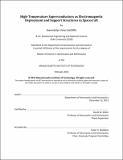| dc.contributor.advisor | David W. Miller. | en_US |
| dc.contributor.author | Gettliffe, Gwendolyn Vines | en_US |
| dc.contributor.other | Massachusetts Institute of Technology. Department of Aeronautics and Astronautics. | en_US |
| dc.date.accessioned | 2013-06-17T20:05:08Z | |
| dc.date.available | 2013-06-17T20:05:08Z | |
| dc.date.copyright | 2012 | en_US |
| dc.date.issued | 2013 | en_US |
| dc.identifier.uri | http://hdl.handle.net/1721.1/79334 | |
| dc.description | Thesis (S.M.)--Massachusetts Institute of Technology, Dept. of Aeronautics and Astronautics, February 2013. | en_US |
| dc.description | This electronic version was submitted and approved by the author's academic department as part of an electronic thesis pilot project. The certified thesis is available in the Institute Archives and Special Collections. | en_US |
| dc.description | Cataloged from department-submitted PDF version of thesis. | en_US |
| dc.description | Includes bibliographical references (p. 128-130). | en_US |
| dc.description.abstract | In this thesis, we investigate a new structural and mechanical technique aimed at reducing the mass and increasing the stowed-to-deployed ratio of spacecraft systems. This technique uses the magnetic fields generated by high-temperature superconductors (HTSs) to support spacecraft structures and deploy them to operational configurations from stowed positions inside a launch vehicle fairing. The chief limiting factor in spacecraft design today is the prohibitively large launch cost per unit mass. Therefore, the reduction of spacecraft mass has been a primary design driver for the last several decades. Traditionally, spacecraft mass reduction occurs through the use of isogrid panels, aluminum or composites, and inflatable beams all reduce the mass of material necessary to build a truss or apply surface forces to a spacecraft structure. We instead look at using electromagnetic body forces generated by HTSs to reduce the need for material, load bearing support, and standoffs on spacecraft by maintaining spacing, stability, and position of elements with respect to one another. The objective of this thesis is to conduct an initial feasibility study for the use of HTS coils as deployment and support elements in spacecraft structures. To accomplish this objective, we have developed the equations of motion for coils responding to electromagnetic forces while under the influence of constraining elements (i.e. tethers and hinged panels) and validated numerical models of these equations against known analytical solutions. By nondimensionalizing the equations of motion, we have been able to reduce our design variable space through the introduction of lumped dimensionless parameters. This enables simpler trade analysis with regards to structure deployment time and equilibrium configuration, the results of which are also presented and discussed. On the basis of these analyses, we provide suggestions for the selection of design values to achieve desired structural characteristics. Finally, we have introduced, and discussed on the basis of our modeling results, the viability of HTS structures in the context of trade analyses. Trades were described at the mission level, the structural subsystem level, and the component level against traditional and more recently developed alternative structural technologies. | en_US |
| dc.description.statementofresponsibility | by Gettliffe, Gwendolyn Vines. | en_US |
| dc.format.extent | 130 p. | en_US |
| dc.language.iso | eng | en_US |
| dc.publisher | Massachusetts Institute of Technology | en_US |
| dc.rights | M.I.T. theses are protected by
copyright. They may be viewed from this source for any purpose, but
reproduction or distribution in any format is prohibited without written
permission. See provided URL for inquiries about permission. | en_US |
| dc.rights.uri | http://dspace.mit.edu/handle/1721.1/7582 | en_US |
| dc.subject | Aeronautics and Astronautics. | en_US |
| dc.title | High-temperature superconductors as electromagnetic deployment and support structures in spacecraft | en_US |
| dc.title.alternative | HTs as electromagnetic deployment and support structures in spacecraft | en_US |
| dc.type | Thesis | en_US |
| dc.description.degree | S.M. | en_US |
| dc.contributor.department | Massachusetts Institute of Technology. Department of Aeronautics and Astronautics | |
| dc.identifier.oclc | 845063015 | en_US |
